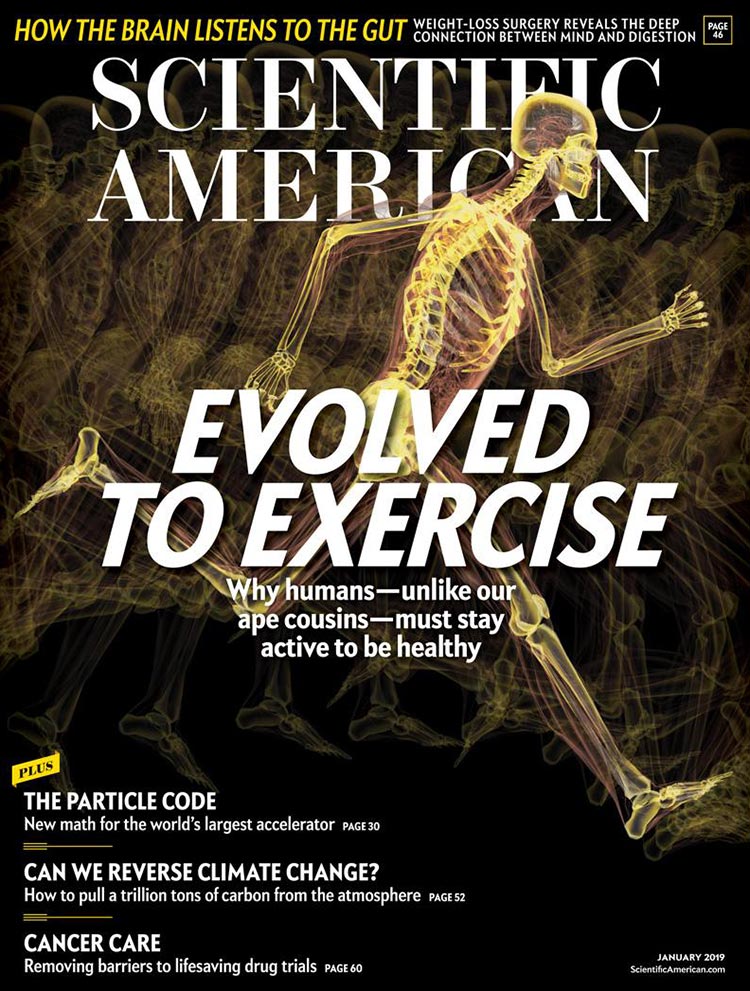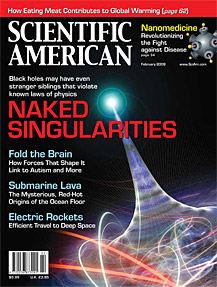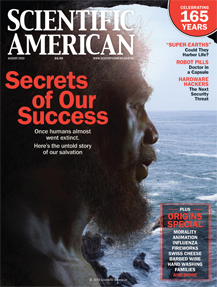The case for scientific humanism

This column was first published in the January 2019 issue of Scientific American.
In the April 2001 issue of Scientific American, I began this column with an entry entitled “Colorful Pebbles and Darwin’s Dictum,” inspired by the British naturalist’s remark that “all observation must be for or against some view, if it is to be of any service.” Charles Darwin penned this comment in a letter addressing those critics who accused him of being too theoretical in his 1859 book On the Origin of Species. They insisted that he should just let the facts speak for themselves. Darwin knew that science is an exquisite blend of data and theory. To these I add a third leg to the science stool—communication. If we cannot clearly convey our ideas to others, data and theory lie dormant.
For 214 consecutive months now, I have tried to communicate my own and others’ thoughts about the data and theory of science as clearly as I am able. But in accordance with (Herb) Stein’s Law—that things that can’t go on forever won’t—this column is ending as the magazine redesigns, a necessary strategy in the evolution of this national treasure, going on 174 years of continuous publication. I am honored to have shared a fleeting moment of that long history, grateful to the editors, artists and production talent for every month I was allowed to share my views with you. I will continue doing so elsewhere until my own tenure on this provisional proscenium ends (another instantiation of Stein’s Law)—many years in the future, nature and chance willing— so permit me to reflect on what I think science brings to the human project of which we are all a part.
Modern science arose in the 16th and 17th centuries following the Scientific Revolution and the adoption of scientific naturalism— the belief that the world is governed by natural laws and forces that are knowable, that all phenomena are part of nature and can be explained by natural causes, and that human cognitive, social and moral phenomena are no less a part of that comprehensible world. In the 18th century the application of scientific naturalism to the understanding and solving of human and social problems led to the widespread embrace of Enlightenment humanism, a cosmopolitan worldview that esteems science and reason, eschews magic and the supernatural, rejects dogma and authority, and seeks to understand how the world works. Much follows. Most of it good.
Human progress, which has been breathtaking over the past two centuries in nearly every realm of life, has principally been the result of the application of scientific naturalism to solving problems, from engineering bridges and eradicating diseases to extending life spans and establishing rights. This blending of scientific naturalism and Enlightenment humanism should have a name. Call it “scientific humanism.”
It wasn’t obvious that the earth goes around the sun, that blood circulates throughout the body, that vaccines inoculate against disease. But because these things are true and because Nicolaus Copernicus, William Harvey and Edward Jenner made careful measurements and observations, they could hardly have found something else. So it was inevitable that social scientists would discover that people universally seek freedom. It was also inevitable that political scientists would discover that democracies produce better lives for citizens than autocracies, economists that market economies generate greater wealth than command economies, sociologists that capital punishment does not reduce rates of homicide. And it was inevitable that all of us would discover that life is better than death, health better than illness, satiation better than hunger, happiness better than depression, wealth better than poverty, freedom better than slavery and sovereignty better than suppression.
Where do these values exist to be discovered by science? In nature—human nature. That is, we can build a moral system of scientific humanism through the study of what it is that most conscious creatures want. How far can this worldview take us? Does Stein’s Law apply to science and progress? Will the upward bending arcs of knowledge and wellbeing reach a fixed upper ceiling?
Remember Davies’s Corollary to Stein’s Law—that things that can’t go on forever can go on much longer than you think. Science and progress are asymptotic curves reaching ever upward but never touching omniscience or omnibenevolence. The goal of scientific humanism is not utopia but protopia—incremental improvements in understanding and beneficence as we move ever further into the open-ended frontiers of knowledge and wisdom. Per aspera ad astra.
read or write comments (1)
This chapter contribution to Scientific American was originally published as “These Truths Are Not Self-Evident—but They’ve Been Firmly Established Over and Over by Scientific Research” (November, 2016). It was co-authored by Michael Shermer, Harriet Hall, Ray Pierrehumbert, Paul Offit, and Seth Shostak.
In a letter to his friend the botanist Joseph Hooker, dated January 14, 1844, Charles Darwin recalled from his voyage around the world in the HMS Beagle: “I was so struck with distribution of Galapagos organisms &c &c…that I determined to collect blindly every sort of fact which cd bear any way on what are species.” After five years at sea and nine years at home thinking about the origin of species Darwin concluded: “At last gleams of light have come, & I am almost convinced, (quite contrary to opinion I started with) that species are not (it is like confessing a murder) immutable.”
Like confessing a murder. Dramatic words. But it doesn’t take a rocket scientist—or an English naturalist—to understand why a theory on the origin of species by means of natural selection would be so controversial: if new species are created naturally—not supernaturally—what place, then, for God? No wonder Darwin waited 20 years before finally publishing his theory in 1859, and why more than a century and a half later people of some religious faiths still find the theory threatening. But that 150+ years have brought together so much evidence in support of the theory that it would be truly astonishing if it turned out not to be true—on par with doubting the Big Bang origin of the universe or the germ theory of disease. Why? Because of a convergence of evidence from many lines of inquiry.
Cosmologists, for example, reconstruct the history of the universe through a convergence of evidence from astronomy, astrophysics, planetary geology, and physics. Geologists reconstruct the history of the Earth through a convergence of evidence from geology, geophysics, and geochemistry. Archeologists piece together the history of civilization through a convergence of evidence from pollen grains, kitchen middens, potshards, tools, works of art, written sources, and other site-specific artifacts. As a historical science, evolution is confirmed by the fact that so many different lines of evidence converge to this single conclusion. Independent sets of data from geology, paleontology, botany, zoology, herpetology, entomology, biogeography, comparative anatomy and physiology, genetics and population genetics, and many other sciences each point to the conclusion that life evolved. (continue reading…)
Comments Off on Evolution is Still True
Genome sequencing has revealed our common humanity
According to the late Harvard University biologist Ernst W. Mayr, the greatest evolutionary theorist since Charles Darwin, “species are groups of actually or potentially interbreeding natural populations which are reproductively isolated from other such groups.”
Reproductive isolation is the key to understanding how new species form, and many types of barriers can divide a population and split it into two different groups: geographic (such as a mountain range, desert, ocean or river), morphological (a change in coloration, body type or reproductive organs), behavioral (a change in breeding season, mating calls or courtship actions), and others. After isolation, if members of the split populations encounter one another and cannot produce viable offspring that can themselves later successfully interbreed and produce viable offspring (hybrids such as mules are infertile), then these two populations constitute two different species. (continue reading…)
read or write comments (58)
On the 200th anniversary of Charles Darwin’s birthday two myths persist about evolution and natural selection

On July 2, 1866, Alfred Russel Wallace, the co-discoverer of natural selection, wrote to Charles Darwin to lament how he had been “so repeatedly struck by the utter inability of numbers of intelligent persons to see clearly or at all, the self acting & necessary effects of Nat Selection, that I am led to conclude that the term itself & your mode of illustrating it, however clear & beautiful to many of us are yet not the best adapted to impress it on the general naturalist public.” The source of the misunderstanding, Wallace continued, was the name itself, in that it implies “the constant watching of an intelligent ‘chooser’ like man’s selection to which you so often compare it,” and that “thought and direction are essential to the action of ‘Natural Selection.’” Wallace suggested redacting the term and adopting Herbert Spencer’s phrase “survival of the fittest.” (continue reading…)
read or write comments (6)
During his book tour Michael Shermer visited the offices of Reason magazine, who have recently added Reason.TV to their media package, a project helped launched by Drew Carey, who turns out to be a big fan of Skeptic magazine and all things skeptical. In this interview Reason magazine editor Nick Gillespie interviews Shermer on his new book, The Mind of the Market.
read or write comments (6)




